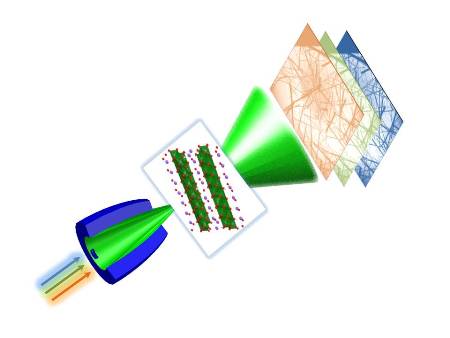Helmholtz Zentrum Berlin (HZB) scientists have created a novel microscope for performing X-ray spectroscopic studies of single nanoparticles and nanostructures at high spatial resolution at the nanoscale.
 This picture schematically shows the studied titanium dioxide rods illuminated by X-rays of various photon energies through a capillary condenser. A high-resolution lens – not shown here – then forms an image of the objects. (Source: HZB)
This picture schematically shows the studied titanium dioxide rods illuminated by X-rays of various photon energies through a capillary condenser. A high-resolution lens – not shown here – then forms an image of the objects. (Source: HZB)
The X-ray microscope at BESSY II, the synchrotron source of HZB, utilizes high-intelligence X-rays to detect the properties and sizes of nanomaterials. To achieve nanoscale spatial resolution, the nanomaterials have to be irradiated with high spectral resolution X-rays and pictured onto a detector utilizing an X-ray lens.
The HZB microscope is ideal for material research, especially for energy study. This tool can capture images of nanostrucutures within object fields having a size of up to 20 x 20 µm2 concurrently with a CCD camera. A library of images at high spatial resolution with spectral data can be obtained by storing image information in tiny energy steps over a specific energy range, which in turn offers data a spectrum of every single nanoparticle or specific nanostructure sections.
These spectra called NEXAFS provide the electronic structure data and individual atom arrangements inside a nanoparticle. The tool’s image library comprises the spectra of several particles and facilitates faster analysis. The researchers utilized the tool to analyze the structure of specially synthesized titanium dioxide nanorods.
HZB’s Physicist, Dr. Peter Guttmann stated that besides offering enhanced spectral resolution of the order 10,000, it allows the recording of spectra 100 folds quicker within large object fields. The HZB electron beam writer is capable of fabricating sophisticated lenses that will enhance the tool’s spatial resolution from the current 25 nm to 10 nm, he said.